Regulatory Elements Governing Transcription in Specialized Myofiber Subtypes*
advertisement
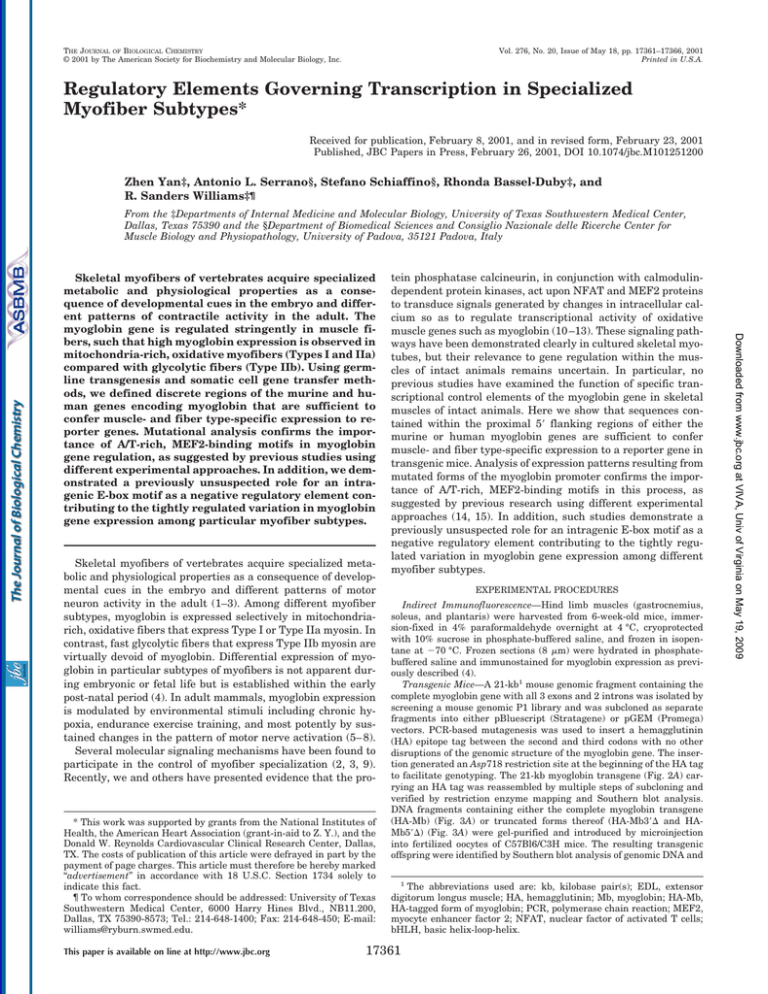
THE JOURNAL OF BIOLOGICAL CHEMISTRY © 2001 by The American Society for Biochemistry and Molecular Biology, Inc. Vol. 276, No. 20, Issue of May 18, pp. 17361–17366, 2001 Printed in U.S.A. Regulatory Elements Governing Transcription in Specialized Myofiber Subtypes* Received for publication, February 8, 2001, and in revised form, February 23, 2001 Published, JBC Papers in Press, February 26, 2001, DOI 10.1074/jbc.M101251200 Zhen Yan‡, Antonio L. Serrano§, Stefano Schiaffino§, Rhonda Bassel-Duby‡, and R. Sanders Williams‡¶ From the ‡Departments of Internal Medicine and Molecular Biology, University of Texas Southwestern Medical Center, Dallas, Texas 75390 and the §Department of Biomedical Sciences and Consiglio Nazionale delle Ricerche Center for Muscle Biology and Physiopathology, University of Padova, 35121 Padova, Italy Skeletal myofibers of vertebrates acquire specialized metabolic and physiological properties as a consequence of developmental cues in the embryo and different patterns of motor neuron activity in the adult (1–3). Among different myofiber subtypes, myoglobin is expressed selectively in mitochondriarich, oxidative fibers that express Type I or Type IIa myosin. In contrast, fast glycolytic fibers that express Type IIb myosin are virtually devoid of myoglobin. Differential expression of myoglobin in particular subtypes of myofibers is not apparent during embryonic or fetal life but is established within the early post-natal period (4). In adult mammals, myoglobin expression is modulated by environmental stimuli including chronic hypoxia, endurance exercise training, and most potently by sustained changes in the pattern of motor nerve activation (5– 8). Several molecular signaling mechanisms have been found to participate in the control of myofiber specialization (2, 3, 9). Recently, we and others have presented evidence that the pro- * This work was supported by grants from the National Institutes of Health, the American Heart Association (grant-in-aid to Z. Y.), and the Donald W. Reynolds Cardiovascular Clinical Research Center, Dallas, TX. The costs of publication of this article were defrayed in part by the payment of page charges. This article must therefore be hereby marked “advertisement” in accordance with 18 U.S.C. Section 1734 solely to indicate this fact. ¶ To whom correspondence should be addressed: University of Texas Southwestern Medical Center, 6000 Harry Hines Blvd., NB11.200, Dallas, TX 75390-8573; Tel.: 214-648-1400; Fax: 214-648-450; E-mail: williams@ryburn.swmed.edu. This paper is available on line at http://www.jbc.org tein phosphatase calcineurin, in conjunction with calmodulindependent protein kinases, act upon NFAT and MEF2 proteins to transduce signals generated by changes in intracellular calcium so as to regulate transcriptional activity of oxidative muscle genes such as myoglobin (10 –13). These signaling pathways have been demonstrated clearly in cultured skeletal myotubes, but their relevance to gene regulation within the muscles of intact animals remains uncertain. In particular, no previous studies have examined the function of specific transcriptional control elements of the myoglobin gene in skeletal muscles of intact animals. Here we show that sequences contained within the proximal 5⬘ flanking regions of either the murine or human myoglobin genes are sufficient to confer muscle- and fiber type-specific expression to a reporter gene in transgenic mice. Analysis of expression patterns resulting from mutated forms of the myoglobin promoter confirms the importance of A/T-rich, MEF2-binding motifs in this process, as suggested by previous research using different experimental approaches (14, 15). In addition, such studies demonstrate a previously unsuspected role for an intragenic E-box motif as a negative regulatory element contributing to the tightly regulated variation in myoglobin gene expression among different myofiber subtypes. EXPERIMENTAL PROCEDURES Indirect Immunofluorescence—Hind limb muscles (gastrocnemius, soleus, and plantaris) were harvested from 6-week-old mice, immersion-fixed in 4% paraformaldehyde overnight at 4 °C, cryoprotected with 10% sucrose in phosphate-buffered saline, and frozen in isopentane at ⫺70 °C. Frozen sections (8 m) were hydrated in phosphatebuffered saline and immunostained for myoglobin expression as previously described (4). Transgenic Mice—A 21-kb1 mouse genomic fragment containing the complete myoglobin gene with all 3 exons and 2 introns was isolated by screening a mouse genomic P1 library and was subcloned as separate fragments into either pBluescript (Stratagene) or pGEM (Promega) vectors. PCR-based mutagenesis was used to insert a hemagglutinin (HA) epitope tag between the second and third codons with no other disruptions of the genomic structure of the myoglobin gene. The insertion generated an Asp718 restriction site at the beginning of the HA tag to facilitate genotyping. The 21-kb myoglobin transgene (Fig. 2A) carrying an HA tag was reassembled by multiple steps of subcloning and verified by restriction enzyme mapping and Southern blot analysis. DNA fragments containing either the complete myoglobin transgene (HA-Mb) (Fig. 3A) or truncated forms thereof (HA-Mb3⬘⌬ and HAMb5⬘⌬) (Fig. 3A) were gel-purified and introduced by microinjection into fertilized oocytes of C57Bl6/C3H mice. The resulting transgenic offspring were identified by Southern blot analysis of genomic DNA and 1 The abbreviations used are: kb, kilobase pair(s); EDL, extensor digitorum longus muscle; HA, hemagglutinin; Mb, myoglobin; HA-Mb, HA-tagged form of myoglobin; PCR, polymerase chain reaction; MEF2, myocyte enhancer factor 2; NFAT, nuclear factor of activated T cells; bHLH, basic helix-loop-helix. 17361 Downloaded from www.jbc.org at VIVA, Univ of Virginia on May 19, 2009 Skeletal myofibers of vertebrates acquire specialized metabolic and physiological properties as a consequence of developmental cues in the embryo and different patterns of contractile activity in the adult. The myoglobin gene is regulated stringently in muscle fibers, such that high myoglobin expression is observed in mitochondria-rich, oxidative myofibers (Types I and IIa) compared with glycolytic fibers (Type IIb). Using germline transgenesis and somatic cell gene transfer methods, we defined discrete regions of the murine and human genes encoding myoglobin that are sufficient to confer muscle- and fiber type-specific expression to reporter genes. Mutational analysis confirms the importance of A/T-rich, MEF2-binding motifs in myoglobin gene regulation, as suggested by previous studies using different experimental approaches. In addition, we demonstrated a previously unsuspected role for an intragenic E-box motif as a negative regulatory element contributing to the tightly regulated variation in myoglobin gene expression among particular myofiber subtypes. 17362 Transcriptional Control of Myofibers used to establish transgenic lines. The proximal promoter region of the mouse myoglobin gene (⫺357 to ⫹55) was isolated by PCR using the P1 clone containing the myoglobin gene as template with a forward primer 5⬘-AGCAAGATGCCTGTGCCCAA-3⬘ and a reverse primer 5⬘-GGAAGATCTGGTGGCTTCTAAAGAGGAC-3⬘. The resulting 430-base pair PCR product was subcloned into PCR II TA vector (Invitrogen), verified by sequence analysis. This myoglobin promoter region was cloned subsequently into the luciferase reporter plasmid pGL3 (Promega) at BglII and Asp718 sites to construct the myoglobin-luciferase reporter plasmid Mb357-Luc. PCR-based sitedirected mutagenesis was then performed using the following primers: Mb⌬E-box 1, forward (5⬘-GCTCCCACAATGGAGCTCGCCCCAAAATAGC-3⬘) and reverse (5⬘-GCTATTTTGGGGCGAGCTCCATTGTGGGAGC-3⬘) (SacI); Mb⌬E-box 3, forward (5⬘-GTGGCCTCAAATCTGCAGTGAGAGCCAGCCC-3⬘) and reverse (5⬘-GGGCTGGCTCTCACTGCAGATTTGAGGCCAC-3⬘) (PstI); Mb⌬A/T, forward (5⬘-GGCACTTGCCCCAAGCTAGCTGCCCATGTG-3⬘) and reverse (5⬘-CACATGGGCAGCTAGCTTGGGGCAAGTGCC-3⬘) (NheI). These mutations disrupt putative binding sites for myogenic regulatory proteins. Mutations were identified by novel restriction sites generated at the site of mutagenesis and confirmed by sequence analysis. The wild type or mutant DNA fragments were gel-purified and introduced by microinjection into fertilized oocytes of C57Bl6/C3H mice. The resulting transgenic offspring were identified by Southern blot analysis of genomic DNA and used for founder analysis. Immunoblot Analysis—Tissues were harvested from either wild type or transgenic mice, disrupted in lysis buffer (1⫻ phosphate-buffered saline, 1% Triton X-100, 20% glycerol, 10 mM EDTA, and protease inhibitor mixture (Roche Molecular Biochemicals)), homogenized with a Teflon pestle, and cleared by centrifugation. Proteins (10 g) were separated by 12% SDS-polyacrylamide gel electrophoresis and immunoblotted with anti-myoglobin antibody (Dako) using the ECL detection system (Amersham Pharmacia Biotech). The intensity of bands was quantified by PhosphorImager/Storm860 analysis (Molecular Dynamics) using ImageQuant software. Regeneration Model—Muscle degeneration/regeneration was induced in Wistar rats as previously described by Schiaffino and colleagues (16) using intramuscular injections of bupivacaine. Plasmid DNA (50 g) containing segments of the human myoglobin gene promoter (19) was introduced into the soleus or extensor digitorum longus (EDL) muscle 3 days after injury. Muscles were harvested 10 days after bupivacaine injection and assayed for reporter activity. Luciferase Assay—Tissues were harvested from transgenic mice at 7–10 weeks of age and assayed for expression of luciferase as previously described (17). RESULTS Stringent Regulation of Myoglobin Protein Expression in Different Myofiber Subtypes—Indirect immunofluorescence analysis of the hind limb muscles of the mouse illustrates the marked differences in expression of myoglobin among different myofibers (Fig. 1). A high level expression of myoglobin was detected in ⬎90% of myofibers in the soleus muscle (Fig. 1B) as expected from previous analyses (4, 18). In the gastrocnemius muscle, the percentage of fibers expressing myoglobin decreases from ⬎75% in the deep portion (Fig. 1B) to ⬃50% in the intermediate region (Fig. 1C) and to ⬍10% in the superficial region (Fig. 1D). Transcriptional Control of the Murine Myoglobin Gene Assessed in Transgenic Mice—In the first phase of this analysis, a 21-kb genomic DNA region encompassing all 3 exons and in- Downloaded from www.jbc.org at VIVA, Univ of Virginia on May 19, 2009 FIG. 1. Stringent regulation of myoglobin gene expression in different myofiber subtypes. Myoglobin protein expression in skeletal muscle of young adult mice (6 weeks old) was detected by indirect immunofluorescence staining of a cross-section from hind limb muscles. A, low magnification view oriented with the deep portion on the left (adjacent to the tibia) and the superficial portion on the right. High magnification images are indicated as insets. B, the deep portion of the hind limb muscles including the soleus (left) and plantaris (right) muscles. C, intermediate portion of the gastrocnemius muscles. D, superficial portion of the gastrocnemius muscle. Each scale bar ⫽ 50 m. Transcriptional Control of Myofibers 17363 tervening sequences of the murine myoglobin gene, as well as 5 kb of 5⬘ flanking DNA and 8.5 kb of 3⬘ flanking DNA, was cloned and modified to serve a reporter function by the insertion of an HA epitope tag into Exon 1 (Fig. 2A). The rationale for this strategy was to preserve the native genomic organization as much as possible. In addition, this approach permits direct assessment of transgene expression in comparison to endogenous myoglobin gene expression at the protein level within the same muscle extracts (Fig. 2B). In transgenic mice established with the 21-kb myoglobin genomic fragment, the transgene product (HA-Mb) was expressed in the tissues of adult animals in a pattern that faithfully recapitulated that of the endogenous myoglobin gene (Fig. 2B). Data from a different transgenic line carrying the same transgene within a different chromosomal insertion site gave the same result (not shown). There was no apparent relationship between copy number of integrated transgenes (estimated to be 3 and 21 in these two transgenic lines) and the pattern of Downloaded from www.jbc.org at VIVA, Univ of Virginia on May 19, 2009 FIG. 2. Schematic diagram and expression pattern of HA-tagged myoglobin transgene. A, a 21-kb mouse genomic fragment contains the intact myoglobin gene with all 3 exons (open boxes for untranslated regions and solid boxes for coding regions) and 2 introns (solid lines between boxes), a 5⬘ flanking region (5 kb) and a 3⬘ flanking region (8.5 kb). PCR-based mutagenesis was used to insert an HA tag (oval with arrowhead) between the second and the third codon. B, immunoblot of tissue extracts from a transgenic mouse carrying the HA-tagged myoglobin transgene, HA-Mb, using antimyoglobin antibodies. The HA-tagged form of myoglobin (HA-Mb) migrates more slowly in the gel than the endogenous myoglobin (Mb) protein. Data from ImageQuant analysis of PhosphorImager scanned immunoblots are presented as a percentage of the endogenous myoglobin in the heart (from two founder lines n ⫽ 4 transgenic animals). C, immunoblot analysis of the developmental expression of HA-tagged myoglobin and endogenous myoglobin in cardiac and skeletal muscles. Data from ImageQuant analysis of PhosphorImager scanned blots are presented as a percentage of the endogenous myoglobin expression in hearts of adult mice (from one founder line n ⫽ 4 transgenic animals). expression of HA-myoglobin. In addition, the developmental timing of the transgene expression mirrored that of the endogenous gene in the cardiac ventricles and atria and in the skeletal muscles of the hind limb; however, the level of expression of HA-myoglobin protein compared with endogenous myoglobin protein was less in adult skeletal muscle (Fig. 2C). The parent 21-kb transgene construction (HA-Mb-WT) was modified to eliminate large segments of the 5⬘ or 3⬘ flanking regions. As illustrated schematically in Fig. 3A, a construct designated as HA-Mb⌬3⬘ removed all but 0.5 kb from the 3⬘ flanking region, whereas a construct designated as HA-Mb⌬5⬘ retained only 0.4 kb of the 5⬘ promoter regions. Transgenic mice carrying these truncated versions of the myoglobin transgene expressed less HA-Mb as a fraction of endogenous myoglobin (HA-Mb-WT; Fig. 3B, upper panels) than mice carrying the HA-Mb transgene. However, the normal pattern of expression among specific muscle groups (e.g. soleus ⬎⬎ white vastus lateralis) was maintained even when most of the 3⬘ and 5⬘ 17364 Transcriptional Control of Myofibers FIG. 4. Human myoglobin promoter after somatic cell gene transfer. Luciferase activity was measured in regenerating rat soleus and EDL muscles 7 days after intramuscular injection of the human myoglobin promoter-reporter plasmids pMb2kb-Luc or pMb380-Luc or of the cytomegalovirus promoter-reporter plasmid CMV-Luc. The data were normalized to RSV-CAT activity and expressed as absolute luciferase activity (left panel) or relative to expression in soleus muscle (right panel). The numbers of animals examined following injection of each plasmid were: pMb2kb-Luc plasmid in soleus (SOL) (n ⫽ 8) and in EDL (n ⫽ 10); pMb380-Luc in soleus (n ⫽ 10) and in EDL (n ⫽ 7); CMV-Luc in soleus (n ⫽ 4) and EDL (n ⫽ 4). RLU, relative light units. flanking regions were deleted from the transgene construction (Fig. 3B, lower panels). Transcriptional Activity of the Human Myoglobin Gene Promoter in Regenerating Muscles of the Rat—Previous studies of the human myoglobin gene promoter in cultured cells (14, 18) and following somatic cell gene transfer into the hearts of intact rats (19) suggested that important transcriptional regulatory elements reside in the proximal 5⬘ flanking region. Here we determined that a segment of the human myoglobin gene extending from ⫺373 to ⫹7 base pairs relative to the transcriptional initiation site is sufficient to direct muscle-specific expression of a luciferase reporter gene in a pattern that mirrors that of the endogenous myoglobin gene. Using a model system characterized extensively by Schiaffino and colleagues (16), plasmid DNA was introduced into the hind limb muscles of adult rats that were undergoing regeneration following chemical injury. Human myoglobin gene promoter fragments linking either 2 or 0.4 kb of 5⬘ flanking sequences to a luciferase reporter gene were expressed more abundantly in the soleus (SOL) than the EDL muscles, reflecting the pattern of the endogenous myoglobin gene (Fig. 4). Absolute levels of luciferase expression were greater with the larger promoter fragment, pMb2kb-Luc, but the fiber type-specific pattern was maintained with both the 2-kb (pMb2kb-Luc) or the ⫺373 to ⫹7 promoter (pMb380-Luc) fragments (Fig. 4, right panel). Specific Nucleotide Sequence Elements Required for Correct Downloaded from www.jbc.org at VIVA, Univ of Virginia on May 19, 2009 FIG. 3. Schematic diagram and expression pattern of HAtagged myoglobin transgene constructs. A, the full-length (21 kb) HA-tagged myoglobin transgene, HA-Mb, is presented as in Fig. 2A. The 5⬘ deletion (HA-Mb⌬5⬘) was constructed by removing a 4.5-kb 5⬘ fragment using restriction enzymes BglII and HindIII. The 3⬘ deletion (HA-Mb⌬3⬘) was constructed by removing an 8.0-kb 3⬘ fragment using restriction enzymes BamHI and HindIII. B, expression pattern of endogenous myoglobin or the myoglobin transgene in soleus (SOL) and white vastus lateralis (WV) muscles of transgenic mice. Data are presented relative to endogenous myoglobin expression in the soleus muscle (top panel) or relative to expression in the soleus muscle of either endogenous myoglobin (Mb) or the transgene product (HA-Mb) (bottom panel). The numbers of animals examined were: HA-Mb-WT, n ⫽ 7; HA-Mb⌬3⬘, n ⫽ 3; and HA-Mb⌬5⬘, n ⫽ 6. Patterning of Murine Myoglobin Promoter Activity—A proximal promoter fragment of the murine myoglobin gene (⫺357 to ⫹55) was linked to a luciferase reporter gene, and this DNA construct (Mb357-Luc) was used to generate transgenic mice. The sequence of this genomic fragment is highly conserved among myoglobin genes of different mammalian species (Fig. 5A). As illustrated in Fig. 5B, the parent Mb357-Luc reporter gene construct was modified by nucleotide substitutions to disrupt specific nucleotide sequence motifs within the myoglobin promoter (Mb⌬A/T-Luc, Mb⌬E-box1-Luc, and Mb⌬E-box3Luc). These sites were chosen for mutational analysis on the basis of their conservation in myoglobin genes of other mammalian species (Fig. 5A) and because of previous data from cell culture models (14, 15, 19). The ⫺357 to ⫹55 segment of the murine myoglobin gene was sufficient to direct high levels of luciferase expression in myoglobin-rich soleus muscles as compared with myoglobin-deficient white vastus lateralis muscles in each of 10 independent transgenic founder mice carrying this transgene (Fig. 5C). In mice, the soleus muscle consists almost entirely of Type I and Type IIa fibers (20) that express endogenous myoglobin (Fig. 1). In contrast, more than 80% of fibers within the white vastus lateralis muscle are Type IIb glycolytic fibers within which the endogenous myoglobin gene is transcriptionally inactive. Mb357-Luc was active selectively in muscle tissues, as evidenced by the high ratio of luciferase activity in heart and soleus skeletal muscle versus liver or lung (⬎20:1) from these animals (not shown). This pattern was consistent in 10 independent founder mice representing different chromosomal insertion sites. Disruption of an A/T-rich, MEF2-binding motif markedly reduced the expression of luciferase in the soleus muscles of transgenic mice compared with the native myoglobin sequence (Mb357⌬A/T-Luc versus Mb357-Luc; Fig. 5C). This result supports the hypothesis that MEF2 proteins serve as important regulators of fiber type-specific gene expression (13). Disruption of an E-box motif adjacent to the A/T-rich, MEF2 binding element in the construct Mb⌬E-box1-Luc had no discernable effect in altering the pattern of transcriptional activity driven by the ⫺380 to ⫹15 myoglobin genomic fragment in transgenic mice (Fig. 5C). We observed in previous studies of the human myoglobin gene promoter in cultured skeletal myotubes that neither of the two conserved E-boxes flanking the MEF2 binding site (E-box1 and E-box2 in Fig. 5) was required for full activity of the myoglobin promoter (14). No previous studies had explored the function of a third conserved E-box motif (E-box3 in Fig. 5A) that we noted to be Transcriptional Control of Myofibers 17365 present within the first exon of myoglobin genes from humans, mice, and rats. Our current analysis of murine myoglobin gene promoter function in transgenic mice indicates that this intragenic E-box motif located downstream of the transcriptional start site (⫹5 to ⫹10) within the 5⬘ untranslated region of exon 1 has an important function. In animals carrying the Mb⌬Ebox3-Luc transgene, luciferase expression was increased in white vastus muscles compared with the activity of the parent pMb357-Luc transgene (Fig. 5C). The Mb⌬E-box3-Luc construct was expressed in soleus muscle to a level equal to or greater than that of the native myoglobin promoter sequence (Mb357-Luc). However, the ratio of expression in soleus versus white vastus lateralis was reduced from ⬃10:1 to 2:1 (Fig. 5C). The E-box3 mutation did not result in ectopic transcriptional activity in non-muscle tissues, since the ratio of expression in soleus muscle relative to lung or liver was unaltered (data not shown). DISCUSSION Luc), E-box3 (Mb⌬E-box3-Luc), or the A/T element (Mb⌬A/T-Luc). C, luciferase activities (corrected for protein concentration) in the soleus (SOL) and white vastus lateralis (WV) muscles from founder transgenic mice are expressed as absolute values (upper panel in log scale), the means of absolute values (middle panel), or the means of paired comparisons relative to expression in the soleus muscle (lower panel). The numbers of founder animals used was: for Mb357-Luc, n ⫽ 10; for Mb357⌬Ebox1-Luc, n ⫽ 5; for Mb357⌬Ebox3-Luc, n ⫽ 8; and for Mb357⌬A/T-Luc, n ⫽ 5. RLU, relative light units. Downloaded from www.jbc.org at VIVA, Univ of Virginia on May 19, 2009 FIG. 5. Sequence elements controlling transcriptional activity of the myoglobin gene promoter. A, DNA sequences from mouse (mMb), human (hMb), rat (rMb), and seal (sMb) myoglobin promoters obtained from GenBankTM (accession numbers X04405, X00371, AF278533, and V00471, respectively) were aligned by DNAstar. Putative regulatory elements are indicated as: E-box1, E-box2, and E-box3, for E-box motifs (CANNTG); A/T for the AT-rich, MEF2 binding site; and TATA for TATA box. The underlined letters below the boxed sequence show nucleotide substitutions generated by site-directed mutagenesis. The numbers designate the nucleotide positions relative to the transcription start site of the mouse myoglobin gene. B, schematic representation of myoglobin-luciferase reporter gene constructs used in mutational analysis. The murine myoglobin 5⬘ promoter region from ⫺357 to ⫹55 was fused to the firefly luciferase gene (Mb357-Luc). PCR-based site-directed mutagenesis disrupted E-box1 (Mb⌬E-box1- Transcription factors and signaling events required to promote myogenic commitment and differentiation have been defined in considerable detail (9, 21). By contrast, the molecular mechanisms by which skeletal myofibers assume one of several highly specialized phenotypes are much less well understood. New findings presented in this study extend the understanding of transcriptional control elements within the myoglobin gene, which serves as a representative of a large set of genes that establish the oxidative (Types I and IIa) myofiber phenotypes. We observed that transcriptional control elements sufficient to recapitulate the pattern of expression of the endogenous myoglobin gene in adult mice are contained within a 21-kb mouse genomic fragment encompassing the myoglobin gene. More detailed analyses indicated that the correct pattern of transcriptional regulation of the myoglobin gene (striated muscles ⬎⬎ non-muscle tissues and soleus ⬎ white vastus lateralis muscle) requires only a small segment of the proximal 5⬘ flanking region extending from nucleotides ⫺357 to ⫹55 relative to the transcriptional start site. Mutations within two protein binding motifs within this region, an A/T-rich, MEF2 binding sequence and an intragenic E-box, disrupt the proper function of this regulatory region. Proteins binding at the A/T-rich element (including but not necessarily limited to MEF2) are required to support high levels of transcription in myofiber subtypes of the soleus muscle (Types I and IIa) that are rich in myoglobin. In contrast, proteins binding at the intragenic Ebox motif appear to repress transcription selectively in myofiber subtypes that are predominant in white vastus lateralis muscles (primarily Type IIb). During the embryonic development of birds or fish, myogenic precursor cells are directed to a fast or slow fiber fate by cues that include sonic hedgehog signaling (22–25). However, the relevance of the hedgehog pathway to the determination and maintenance of specialized phenotypes in innervated adult myofibers has not been addressed. We have proposed a model in which the dominant influence of the sustained, tonic patterns of motor neuron activity that establish the slow (Type I) or oxidative (Type I and IIa) myofiber phenotypes is directed to the relevant target genes, at least in part, by MEF2 and NFAT 17366 Transcriptional Control of Myofibers Acknowledgments—We thank Dr. Kathy Graves, Brian Mercer, Caroline Humphries, Ling Lin, April Hawkins, and John Shelton for excellent technical assistance. We are grateful to Hai Wu for useful discussions. REFERENCES 1. Williams, R. S., and Neufer, P. D. (1996) in The Handbook of Physiology: Integration of Motor, Circulatory, Respiratory and Metabolic Control during 2. 3. 4. 5. 6. 7. 8. 9. 10. 11. 12. 13. 14. 15. 16. 17. 18. 19. 20. 21. 22. 23. 24. 25. 26. 27. 28. 29. 30. 31. 32. 33. 34. 35. 36. 37. 38. 39. 40. 41. 42. Exercise (Rowell, L. B., and Shepherd, J. T., eds) pp. 1124 –1150, American Physiology Society, Bethesda, MD Schiaffino, S., and Reggiani, C. (1996) Physiol. Rev. 76, 371– 423 Booth, F. W., and Baldwin, K. M. (1996) in The Handbook of Physiology: Integration of Motor, Circulatory, Respiratory and Metabolic Control during Exercise (Rowell, L. B., and Shepherd, J. T., eds) pp. 1075–1123, American Physiology Society, Bethesda, MD Garry, D. J., Bassel-Duby, R. S., Richardson, J. A., Grayson, J., Neufer, P. D., and Williams, R. S. (1996) Dev. Genet. 19, 146 –156 Kanatous, S. B., DiMichele, L. V., Cowan, D. F., and Davis, R. W. (1999) J. Appl. Physiol. 86, 1247–1256 Neufer, P. D., Ordway, G. A., and Williams, R. S. (1998) Am. J. Physiol. 274, C341–346 Underwood, L. E., and Williams, R. S. (1987) Am. J. Physiol. 252, C450 –C453 Holloszy, J. O., and Booth, F. W. (1976) Annu. Rev. Physiol. 38, 273–291 Olson, E. N., and Williams, R. S. (2000) Cell 101, 689 – 692 Delling, U., Tureckova, J., Lim, H. W., De Windt, L. J., Rotwein, P., and Molkentin, J. D. (2000) Mol. Cell. Biol. 20, 6600 – 6611 Bigard, X. A., Sanchez, H., Zoll, J., Mateo, P., Rousseau, V., Veksler, V., and Ventura-Clapier, R. (2000) J. Biol. Chem. 275, 19653–19660 Chin, E. R., Olson, E. N., Richardson, J. A., Yang, Q., Humphries, C., Shelton, J. M., Wu, H., Zhu, W., Bassel-Duby, R., and Williams, R. S. (1998) Genes Dev. 12, 2499 –2509 Wu, H., Naya, F. J., McKinsey, T. A., Mercer, B., Shelton, J. M., Chin, E. R., Simard, A. R., Michel, R. N., Bassel-Duby, R., Olson, E. N., and Williams, R. S. (2000) EMBO J. 19, 1963–1973 Bassel-Duby, R., Hernandez, M. D., Gonzalez, M. A., Krueger, J. K., and Williams, R. S. (1992) Mol. Cell. Biol. 12, 5024 –5032 Grayson, J., Williams, R. S., Yu, Y. T., and Bassel-Duby, R. (1995) Mol. Cell. Biol. 15, 1870 –1878 Jerkovic, R., Argentini, C., Serrano-Sanchez, A., Cordonnier, C., and Schiaffino, S. (1997) Cell Struct. Funct. 22, 147–153 Yang, Q., Bassel-Duby, R., and Williams, R. S. (1997) Mol. Cell. Biol. 17, 5236 –5243 Devlin, B. H., Wefald, F. C., Kraus, W. E., Bernard, T. S., and Williams, R. S. (1989) J. Biol. Chem. 264, 13896 –13900 Bassel-Duby, R., Grohe, C. M., Jessen, M. E., Parsons, W. J., Richardson, J. A., Chao, R., Grayson, J., Ring, W. S., and Williams, R. S. (1993) Circ. Res. 73, 360 –366 Burkholder, T. J., Fingado, B., Baron, S., and Lieber, R. L. (1994) J. Morphol. 221, 177–190 Olson, E. N., and Klein, W. H. (1994) Genes Dev. 8, 1– 8 Duprez, D., Lapointe, F., Edom-Vovard, F., Kostakopoulou, K., and Robson, L. (1999) Mech. Dev. 82, 151–163 Norris, W., Neyt, C., Ingham, P. W., and Currie, P. D. (2000) J. Cell Sci. 113, 2695–2703 Cann, G. M., Lee, J. W., and Stockdale, F. E. (1999) Anat. Embryol. 200, 239 –252 Blagden, C. S., Currie, P. D., Ingham, P. W., and Hughes, S. M. (1997) Genes Dev. 11, 2163–2175 Naya, F. J., Mercer, B., Shelton, J., Richardson, J. A., Williams, R. S., and Olson, E. N. (2000) J. Biol. Chem. 275, 4545– 4548 Dunn, S. E., Chin, E. R., and Michel, R. N. (2000) J. Cell Biol. 151, 663– 672 Swoap, S. J., Hunter, R. B., Stevenson, E. J., Felton, H. M., Kansagra, N. V., Lang, J. M., Esser, K. A., and Kandarian, S. C. (2000) Am. J. Physiol. 279, C915–C924 Murgia, M., Serrano, A. L., Calabria, E., Pallafacchina, G., Lomo, T., and Schiaffino, S. (2000) Nat. Cell Biol. 2, 142–147 O’Mahoney, J. V., Guven, K. L., Lin, J., Joya, J. E., Robinson, C. S., Wade, R. P., and Hardeman, E. C. (1998) Mol. Cell. Biol. 18, 6641– 6652 Spitz, F., Demignon, J., Porteu, A., Kahn, A., Concordet, J. P., Daegelen, D., and Maire, P. (1998) Proc. Natl. Acad. Sci. U. S. A. 95, 14220 –14225 Spitz, F., Demignon, J., Kahn, A., Daegelen, D., and Maire, P. (1999) J. Mol. Biol. 289, 893–903 Hughes, S. M., Taylor, J. M., Tapscott, S. J., Gurley, C. M., Carter, W. J., and Peterson, C. A. (1993) Development 118, 1137–1147 Hughes, S. M., Chi, M. M., Lowry, O. H., and Gundersen, K. (1999) J. Cell Biol. 145, 633– 642 Zhang, C. L., McKinsey, T. A., Lu, Jr., and Olson, E. N. (2001) J. Biol. Chem. 276, 35–39 McKinsey, T. A., Zhang, C. L., Lu, J., and Olson, E. N. (2000) Nature 408, 106 –111 Simon, A. M., and Burden, S. J. (1993) Mol. Cell. Biol. 13, 5133–5140 Ceccarelli, E., McGrew, M. J., Nguyen, T., Grieshammer, U., Horgan, D., Hughes, S. H., and Rosenthal, N. (1999) Dev. Biol. 213, 217–229 Kraner, S. D., Rich, M. M., Sholl, M. A., Zhou, H., Zorc, C. S., Kallen, R. G., and Barchi, R. L. (1999) J. Biol. Chem. 274, 8129 – 8136 Lu, J., Webb, R., Richardson, J. A., and Olson, E. N. (1999) Proc. Natl. Acad. Sci. U. S. A. 96, 552–557 Massari, M. E., and Murre, C. (2000) Mol. Cell. Biol. 20, 429 – 440 Postigo, A. A., and Dean, D. C. (1997) EMBO J. 16, 3935–3943 Downloaded from www.jbc.org at VIVA, Univ of Virginia on May 19, 2009 proteins under the post-translational regulation of calcineurin, CaMK (calmodulin-dependent protein kinase), and possibly other calcium-regulated signaling pathways (9, 12, 13, 26). This viewpoint has been supported by data from other laboratories (10, 11), but a central role for this mechanism has been questioned by others (27, 28). As we have discussed elsewhere (9), our model should not be interpreted as excluding important roles for other transcription factors in addition to MEF2 and NFAT in the mechanisms of fiber type-specific gene regulation. To the contrary, compelling data implicate Ras (29), MusTRD (30), SIX (31), and nuclear receptor (32) proteins in regulation of certain genes that are expressed selectively in particular myofiber subtypes. However, binding sites for MusTRD, SIX, and nuclear receptor proteins are not evident within the control region of the myoglobin gene that we have shown to be sufficient for soleus-specific transcription. The results from the present analysis add support to the notion that MEF2 transcription factors and other proteins that form complexes at the myoglobin A/T-rich element are important to the stringently regulated expression of myoglobin among different myofiber subtypes (13). Other new observations presented here are of particular interest in light of previous data that suggest a role for bHLH proteins in fiber type-specific gene regulation. Hughes and colleagues (33) noted an increased ratio of myogenin to MyoD in soleus versus EDL muscles of rats; they generated transgenic mice to overexpress myogenin in fast, glycolytic fibers under the control of the myosin light chain 1/3 promoter/enhancer. Expression of this transgene increased the abundance of oxidative fibers within the EDL, although it did not promote increased expression of Type I myosin (34). These data implicate bHLH proteins in the specialization of fast fibers into oxidative and glycolytic subtypes, an issue pertinent to myoglobin gene regulation. Our findings with respect to the myoglobin E-box3 element provide the first evidence that bHLH proteins may participate directly in fiber type-specific transcription of the myoglobin gene. The identity of the repressor factor or factors that recognize this particular E-box motif remains to be determined. It is possible that, like MEF2 (35, 36), bHLH proteins of the MyoD family can form complexes with co-repressors to negatively regulate gene expression in certain cell backgrounds or in the absence of appropriate activating stimuli that unmask their transcriptional activation domains. On the other hand, other E-box binding proteins are known to function as transcriptional repressors (37– 42) and may serve as cognate factors that recognize the myoglobin E-box3 element. Stringent regulation of myoglobin gene expression among different myofiber subtypes (Fig. 1) seems likely to demand both positive and negative control mechanisms. This study provides evidence for such dual regulation, opening new opportunities to enhance the fundamental understanding of the molecular basis of myofiber specialization.
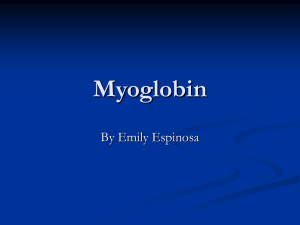
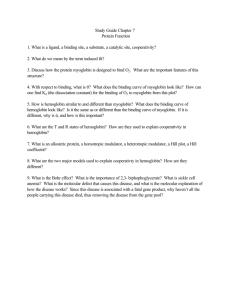
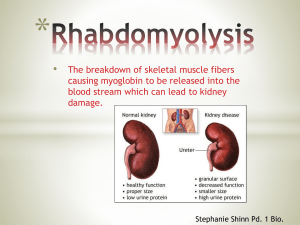
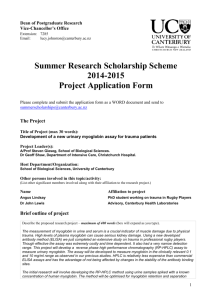
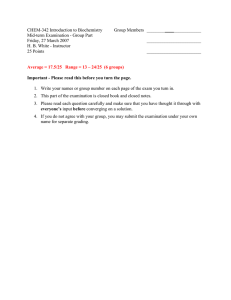
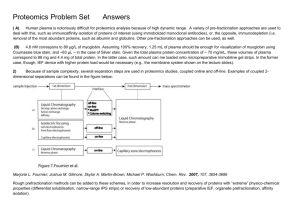
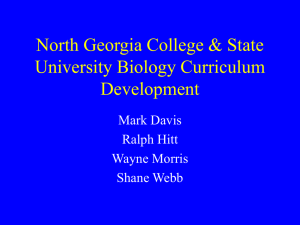
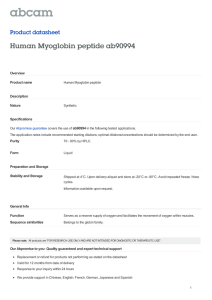
![Anti-Myoglobin antibody [BDI572] ab19610 Product datasheet Overview Product name](http://s2.studylib.net/store/data/013697447_1-431070228b2317aa0ca8e8e8926b81d5-300x300.png)